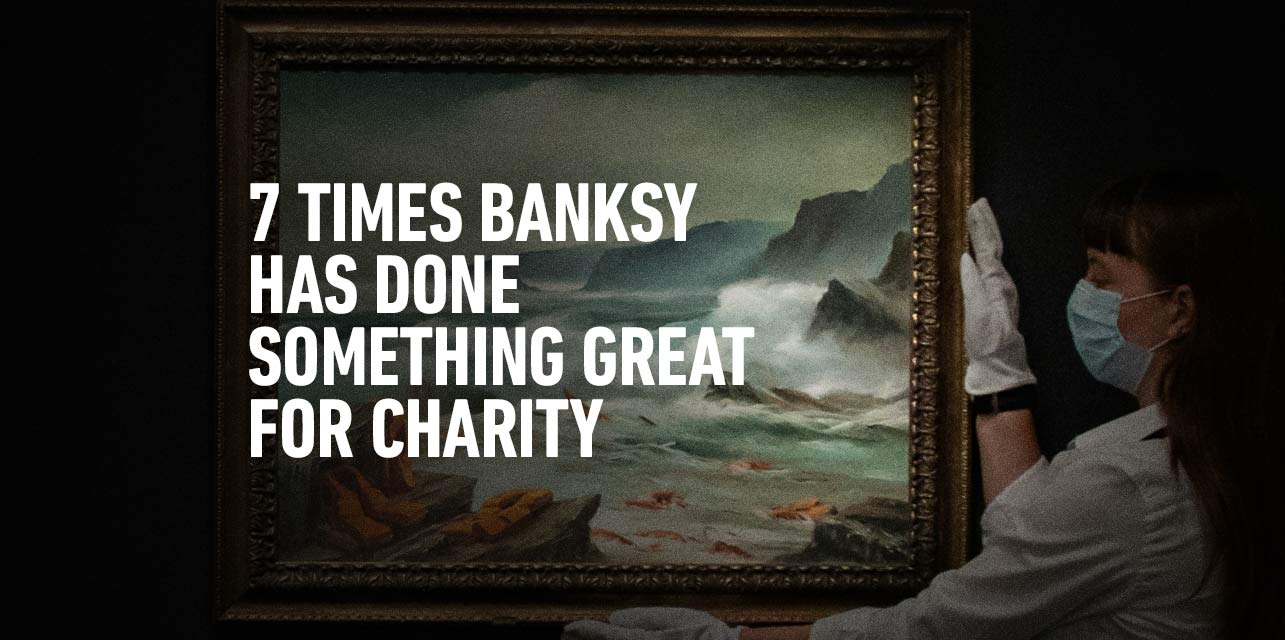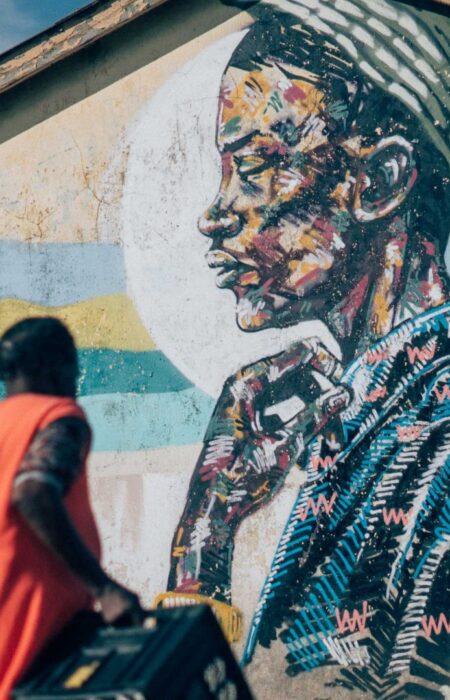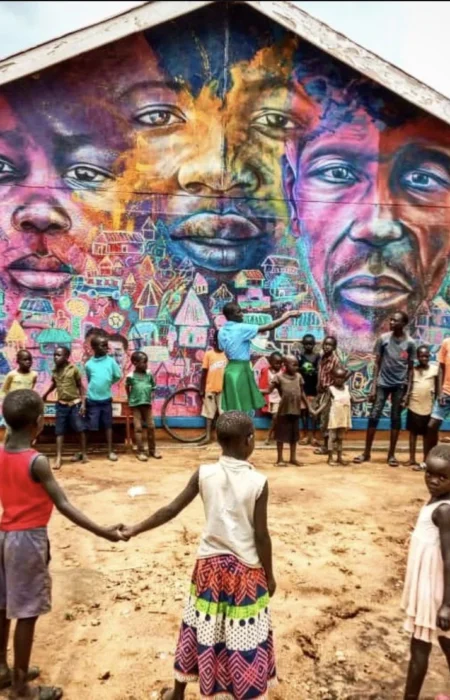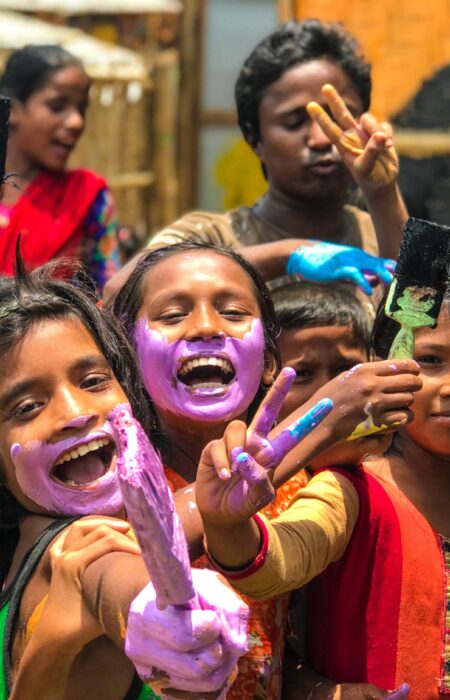Banksy, the mysterious and provocative street artist, is famous for his powerful and often controversial artworks. However, beneath his enigmatic persona lies a surprising philanthropic side. Yes, you read that right – this anonymous artist has used his talents to contribute positively to society.
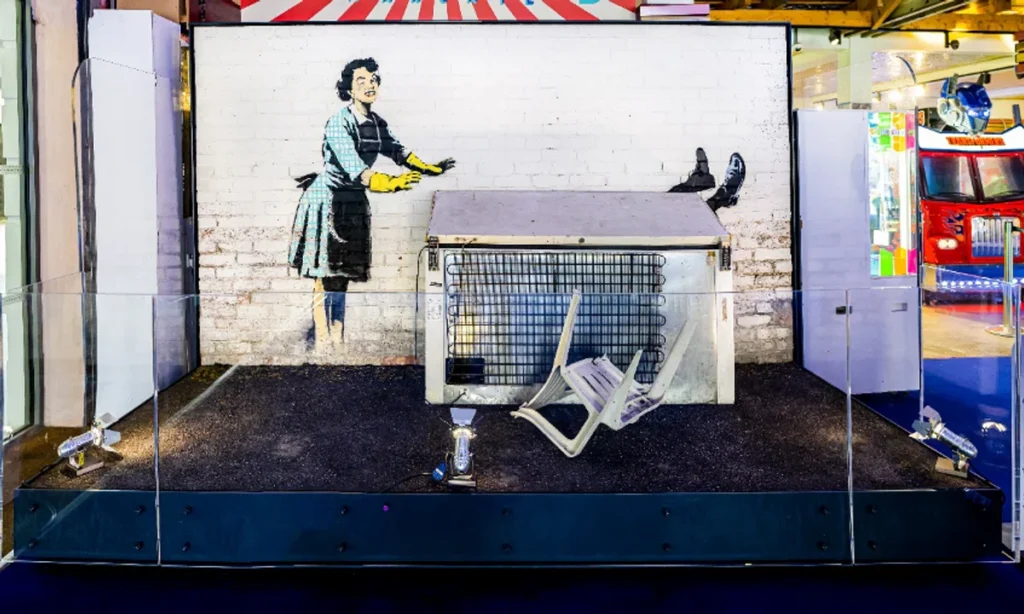
Let’s explore some of the remarkable charitable acts that Banksy has been a part of.
Understanding Banksy’s Charitable Nature
It might surprise many to learn that the elusive Banksy, known for his secretive nature, has a genuine passion for helping others. While his true identity remains unknown, his charitable contributions have earned admiration from both art lovers and philanthropists.
Banksy’s charitable efforts extend beyond just monetary donations. He approaches philanthropy in a creative, unconventional way, using his art to support important causes. Through his work, Banksy seeks to provoke thought, spark dialogue, and inspire action toward positive change.
Banksy’s Creative Approach to Charity
When it comes to giving back, Banksy’s ingenuity knows no limits. Rather than simply writing a check, he channels his artistic talents to make a lasting impact. Whether it’s converting an abandoned building into a pop-up art gallery or painting powerful murals in underprivileged areas, Banksy’s method of charity is as distinctive as his artistic style.
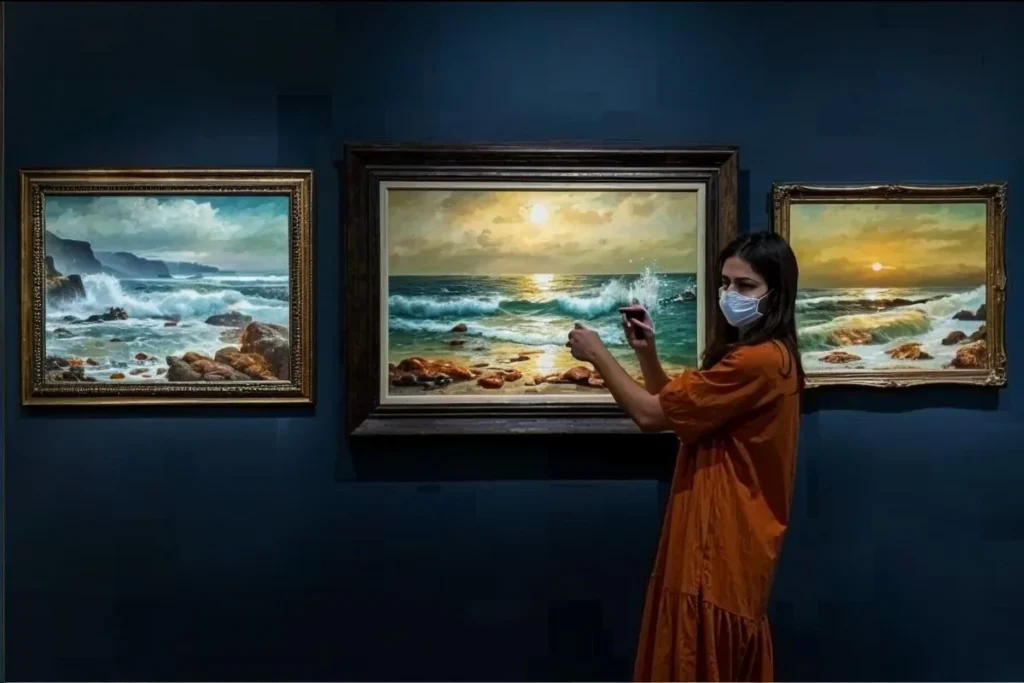
A Noteworthy Example: Banksy’s “Dismaland”
One standout instance of Banksy’s unorthodox approach to charity is his 2015 “Dismaland” project. He transformed a rundown amusement park into a surreal, dystopian world filled with subversive art installations and thought-provoking exhibits. The purpose of the project was to critique the commercialization of art and shed light on pressing social and political issues.
Why Banksy Engages in Charity
So, what motivates Banksy to take part in charitable efforts? Is it the fame or recognition? The truth is, the reasons behind his charitable actions are as elusive as his true identity. While some suggest that he’s genuinely motivated by a desire to use his art for positive change, others believe it’s simply another way for him to push boundaries and challenge the establishment.

The Impact of Banksy’s Philanthropy
One thing is clear: Banksy’s charitable actions have left a lasting mark on both the art world and society. His remarkable ability to merge activism with art has made him a formidable agent for change. By keeping his identity a secret, Banksy shifts the focus away from himself, allowing attention to remain squarely on the issues he aims to address.
It’s this sense of mystery that enhances the intrigue surrounding Banksy’s charitable work. His anonymity empowers his art to speak volumes on its own, breaking free from the confines of traditional galleries and reaching a broader audience. Whether he’s drawing attention to the struggles of refugees, advocating for animal rights, or raising awareness about environmental concerns, Banksy’s acts of charity continue to inspire and provoke action.
Some of Banksy’s Most Notable Charitable Works
Now, let’s explore a few of the standout charitable contributions that Banksy has made over the years. From eye-opening art installations to pieces sold for a good cause, his philanthropic endeavors are truly inspiring.
The Walled Off Hotel: A Charity-Focused Art Installation
In 2017, Banksy opened The Walled Off Hotel in Bethlehem, Palestine. Located just a few meters from the Israeli separation wall, this one-of-a-kind hotel offers an immersive experience that highlights the Israeli-Palestinian conflict. The exterior of the hotel features striking graffiti that reflects Banksy’s distinctive style and political messages.

Inside the hotel, each room is carefully crafted to showcase the harsh realities of life in the region. From walls riddled with bullet holes to artworks illustrating the struggles of the Palestinian people, every aspect serves as a poignant reminder of the ongoing fight for peace and justice. The Walled Off Hotel not only creates jobs for the local community but also directs its profits to organizations that support Palestinian causes, making a real impact on the lives of those affected by the conflict.
Dismaland: A Dark Take on Theme Parks with a Purpose
In 2015, Banksy transformed an abandoned seaside resort in Weston-super-Mare into Dismaland, a dystopian theme park. This temporary art installation drew thousands of visitors from across the globe, eager to experience Banksy’s subversive twist on the conventional amusement park. The park featured a variety of exhibits and installations, all designed to question societal norms and raise awareness about important global issues.

Dismaland featured a range of unsettling and satirical attractions, from a decaying Cinderella castle to a distorted carousel. Banksy’s aim was clear: to spotlight critical issues like consumerism, immigration, and political corruption. While the exhibit was a temporary installation, its impact was lasting, as proceeds from ticket sales were donated to various charitable causes, ensuring that Dismaland’s influence went beyond the art world.
The Sale of ‘Girl with a Balloon’ for a Cause
In 2018, one of Banksy’s most famous pieces, Girl with a Balloon, made headlines when it was auctioned. The artwork, showing a young girl reaching for a heart-shaped balloon, struck a chord with people around the globe. However, shortly after the auctioneer’s gavel fell, the piece began to self-destruct before the stunned eyes of the audience, leaving them in awe and adding a new layer of meaning to the artwork’s already profound impact.

The shocking self-destruction of Girl with a Balloon only intensified the mystery and allure of Banksy’s work. Despite the artwork being shredded in front of onlookers, it was eventually sold for an astonishing amount. True to his philanthropic nature, Banksy pledged to donate a significant portion of the proceeds to charity. This dramatic event not only underscored the ephemeral quality of art but also reinforced Banksy’s dedication to using his art as a platform for positive social impact.
Save or Delete: Banksy and Greenpeace’s Environmental Campaign
In 2002, Banksy collaborated with Greenpeace for the Save or Delete campaign, a powerful piece aimed at drawing attention to deforestation. The artwork depicted beloved characters from Disney’s The Jungle Book, bound and blindfolded against the backdrop of a ravaged jungle landscape. Through this thought-provoking image, Banksy used his art to spotlight environmental issues and encourage global action.

The Save or Delete image, which featured familiar characters from Disney’s The Jungle Book, was initially intended to be used on posters, billboards, and postcards by Greenpeace to raise awareness about deforestation. However, due to Disney’s policies, these materials were never released to the public. Despite this, a version of the poster can be found in Banksy’s Wall and Piece (p. 161), and the print has since been featured and sold at multiple auctions, continuing to draw attention to both the artwork and its underlying environmental message.
Christmas Mural in Birmingham: A Heartfelt Statement on Homelessness
In 2019, Banksy created a poignant Christmas mural in Birmingham, depicting two reindeer pulling a bench with a homeless man named Ryan sleeping on it. The artwork was accompanied by a film shared on Banksy’s social media, showcasing Ryan’s experience. The video highlighted the generosity of passers-by, with Banksy noting: “God bless Birmingham. In the 20 minutes we filmed Ryan on this bench, passers-by gave him a hot drink, two chocolate bars, and a lighter – without him ever asking for anything.” This powerful mural not only captured the spirit of the holiday season but also drew attention to the ongoing issue of homelessness.

Following the release of his powerful Christmas mural in Birmingham, Banksy continued his support for the homeless community. The next day, it was revealed that he had created T-shirts and merchandise for a concert in Bristol, with all proceeds going to homeless charities. The organizations benefiting from this initiative included The Wild Goose, 1625 Independent People, Feed the Homeless Bristol, and Somewhere to Go. This initiative further demonstrated Banksy’s commitment to using his art to make a real-world impact, helping those in need.
The mural soon became the target of some mischief, with a red nose appearing on one of the reindeers. In an effort to protect the artwork, the council installed Perspex shielding around it, but that couldn’t prevent the occasional defacement. Despite this, the mural eventually found a new home at auction, where it sold for £2,300 at Fellows Auctioneers in Birmingham. All proceeds from the sale were donated to the Midland Langar Seva Society (MLSS), an organization dedicated to helping the homeless in the UK.
Mobile Lovers: A Youth Club Mural
In April 2014, Banksy created a mural titled Mobile Lovers, which appeared on the doors of a youth club in Bristol that was facing closure. The mural, depicting a couple embracing while seemingly taking selfies, became an instant cultural commentary on modern relationships and technology. However, shortly after its unveiling, the youth club’s owner decided to move the artwork inside the club and offered it for viewing in exchange for optional donations.
This decision sparked controversy when, within days, the police confiscated the mural and handed it over to the local council, sparking debates over the ownership and public accessibility of Banksy’s work. Despite the tensions, the mural became yet another example of how Banksy’s art not only speaks to social issues but also often gets tangled in legal and ethical battles.

Banksy, however, officially handed over Mobile Lovers to the youth club’s owner in a letter, confirming the mural’s transition. The owner then sold the piece for an undisclosed sum to a private collector, with all profits going to Broad Plain Working With Young People, a charity dedicated to supporting youth in Bristol. The mural eventually fetched over £400,000 at auction, providing a vital lifeline for the youth club. This generous act not only sustained the club but also underscored Banksy’s deep commitment to supporting the local community, particularly youth in Bristol, where the artist himself grew up.
Mediterranean Sea View: Raising Funds for a Hospital in Bethlehem
In another powerful act of charity, Banksy donated three oil paintings spotlighting the European migrant crisis, including Mediterranean Sea View (2017), to raise funds for a hospital in Bethlehem. The triptych was sold for an impressive £2.23 million at Sotheby’s From Rembrandt to Richter evening sale, with all proceeds directed toward the building of a new medical facility. This gesture reflected Banksy’s ongoing engagement with global humanitarian issues, using his art to raise both awareness and vital funds for causes in need.

The Impact of Banksy’s Charitable Actions
Beyond the immediate beneficiaries of his charitable acts, Banksy’s contributions have had a far-reaching impact, transcending art and reaching global audiences to inspire tangible change.
One of the most significant ways in which Banksy’s charitable actions have made a difference is through the way his art raises awareness. His works have a unique ability to capture attention, spark conversation, and challenge societal norms. By using his distinctive style and thought-provoking imagery, Banksy consistently brings crucial social and political issues to the forefront of public consciousness. His powerful messages resonate deeply with viewers, encouraging them to think critically about the world around them.
For example, one of Banksy’s most famous artworks, Girl with a Balloon, depicts a young girl reaching out for a heart-shaped balloon, only to see it slip away. This image has been interpreted as a commentary on the fleeting nature of love, hope, and human aspiration. It sparks conversations about the impermanence of happiness and the need to cherish the present moment. Through this artwork, Banksy not only raised awareness about the fragility of human emotions but also prompted larger conversations about the importance of appreciating what we have while we can.
In addition to raising awareness, Banksy’s charitable actions have also had a significant financial impact. While the exact amount raised for charity remains a mystery, his fundraising efforts—whether through direct donations or the auctioning of his artworks—have provided vital support to numerous organizations working to address social inequality and humanitarian crises. His works have been sold for millions, with the proceeds benefiting a range of charitable causes across the globe.
One notable example of Banksy’s financial contributions is his collaboration with the charity organization Help Refugees. In 2015, Banksy created a series of artworks in the Calais refugee camp, known as the “Jungle.” These works directly addressed the plight of refugees, sparking attention and raising funds for the refugees’ survival and care. Through such efforts, Banksy has helped fund numerous humanitarian initiatives, reinforcing how art can be used as a force for good.

These powerful murals that Banksy created in the Calais refugee camp are just one example of how his art has shed light on the struggles of refugees and displaced people. The poignant depictions of their plight, displayed in one of the most dire refugee settlements in Europe, not only created an emotional connection with the viewers but also provided a rallying point for those who wished to support the cause. The subsequent auctioning of these artworks raised essential funds that directly benefited the refugees, offering them access to critical resources and aid in their time of need.
But Banksy’s charitable influence goes far beyond providing financial assistance. His actions have become a catalyst for others to get involved in social causes, using their skills, art, and resources to contribute positively to the world. By seeing how one artist could make a tangible difference, people across the globe, both within the art world and beyond, have been motivated to take action. In this way, Banksy’s charitable work doesn’t just fund charities; it sparks a movement, encouraging others to follow suit and leverage their talents for the common good.
The Ripple Effect of Banksy’s Actions
By seamlessly blending art with activism, Banksy has demonstrated how creative expression can be a powerful tool for social change. His work challenges societal norms and redefines how we view the relationship between art, charity, and social responsibility. For artists, his example proves that they can use their platforms to advocate for the causes they care about, whether through direct fundraising, raising awareness, or prompting broader societal conversations.
Banksy’s ability to use his art to create a lasting impact, even while maintaining his anonymity, shows that the power of art goes beyond the canvas—it has the power to influence change, mobilize communities, and inspire empathy. His charitable endeavors have reminded us of the role of compassion in art and the responsibility that creators have to use their work for the betterment of society.
In conclusion, Banksy’s charitable contributions offer more than just financial aid. They amplify crucial messages about social and political issues, empower other artists to engage in activism, and inspire us all to take action. Through his art, Banksy has solidified his role not only as an influential figure in the art world but as a symbol of the transformative power of creativity and compassion in making the world a better place.





